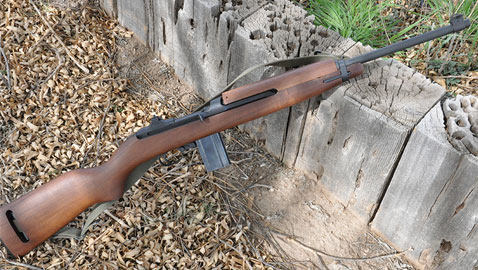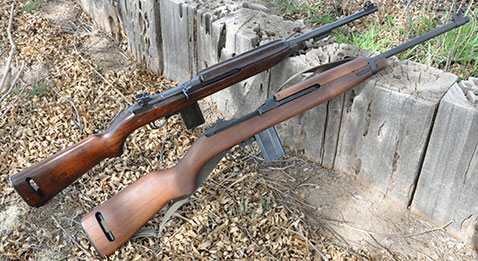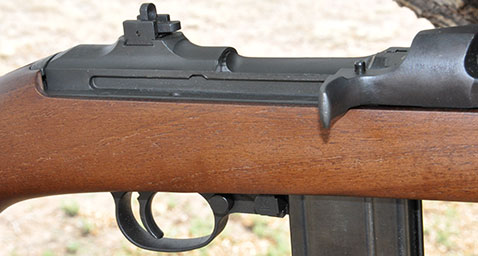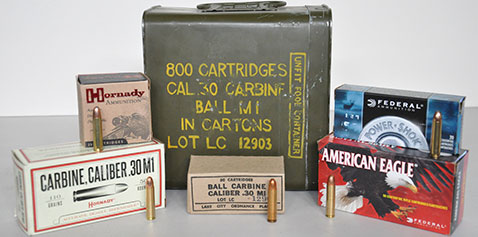
Some years ago I was sitting around drinking with some Border Patrol and SEAL buddies when someone spotted an advertisement for M1 carbines in Shotgun News. These were genuine U.S. military carbines being re-imported from Korea where they had been since the Korean War. The price was pretty good – something like $136 each – so, fueled by alcohol and testosterone, we all ordered one and I was elected to make the arrangements.
Why me? Well, our Border Patrol office had a Federal Firearms License. A week or two later I was out “patrolling the border”, which probably meant goofing off, shooting and having fun, when a radio call summoned me to sector headquarters and the office of the Chief Patrol Agent. The Chief was known to be a man not kindly disposed towards the antics of junior agents so I ran down my list of recent sins and transgressions while driving to his office. Arriving there I was greeted by a blast of hot air that roughly translated meant,” What are you up to now? Planning a revolution? Equipping your private army?”
You see, stacked in the corner were boxes containing the dozen M1 carbines I ordered without bothering to notify anyone what to expect when they arrived. After I performed a lively and sincere Matame the Chief ran out of steam and ordered me to take the offending boxes from his office. What’s a Matame, you ask? Well, in Spanish it means, “kill me”. It comes from the antics of very drunk or drugged up illegal aliens who, when confronted, wave their tequila bottle about, rip their clothing and scream, “Matame, matame, pero no me pegas!”, which translates to, “Kill me, kill me but don’t hit me!” As a result, what might otherwise be referred to as a rug dance is called “doing a Matame” among border denizens.

Okay, back to the carbines, since I had picked up the order I assumed the privilege of rooting through them to pick one for myself. Spying a genuine Winchester I latched onto it and have it to this day.
The M1 carbine was conceived during World War II as a lighter, smaller semi-automatic alternative to the M1 Garand battle rifle. Some dimwit also surmised that tankers, drivers, officers, clerks and others should be stripped of their 1911 pistols and given carbines instead. That plan didn’t work out too well, as anyone with half a brain in combat did their best to latch on to a pistol, but the carbine went into production and gazillions were made by a number of manufacturers. As a matter of fact, more M1 carbines, some 6 million of them, were manufactured in the United States during the war period than any other small arm.
Despite being prolific the carbine was not without controversy. Firing a .30 caliber 110 grain full metal jacket round nosed bullet at about 2,000 feet per second it was way less powerful than the .30 caliber round fired by the M1 Garand – a .30-06. Some people hated the carbine while others loved its handling characteristics and felt it had sufficient power for short-range engagements.
Variations of it were produced with folding stocks, called paratrooper models, and full auto models are called M2s. The standard magazine holds 15 rounds and 30 round magazines are available as well.

After the war the little carbine became popular with American law enforcement and anyone who wanted a light, fast shooting and handy carbine. Weighing about 5 pounds empty, with an 18” barrel, being just a touch under 3 feet in length and having very little recoil the carbine was hugely popular in the post war era.
Legendary figures such as Texas Ranger Joaquin Jackson and civil rights revolutionary Malcolm X were photographed with their M1 carbines. Not until the AR-15 became available to the civilian market in the late 1960s did the popularity of the M1 carbine begin to wane.
These days I doubt there is a police department still carrying them but I know there are hundreds of thousands, maybe millions, in storerooms, closets and gun safes and the carbine is still in use with police and military forces throughout the world.
Produced by several commercial manufacturers since WWII, the M1 carbine these days is most often found in the Auto Ordnance lineup that is part of Kahr Arms and that’s the version I have for testing. I wanted to try one out because Federal, Hornady and others now produce defensive ammunition that is way better than the military ball round and I thought the M1 still might have a place in the defensive arsenal with this improved ammunition.
After considering various accessories to add scopes, lights and so on, I realized the strength of the M1 lies in its simplicity, light weight and handling characteristics and figured if you want to hang all that stuff on your carbine there are far better platforms these days than the M1.

I ordered some modern ammunition from Hornady and Federal and, rooting around in the ammo bunker, pulled out some Lake City military .30 Carbine ammo that’s probably more than 60 years old and looks brand new. Interestingly, .30 Carbine ammunition was the first to be produced for the military with non-corrosive primers.
I declined to shoot the Auto-Ordnance carbine for group at 100 yards because, without a scope and using iron sights, the results would be poor. Besides, the military standard for M1 carbines is 3-5” groups at 100 yards.
These carbines were made for shooting enemy soldiers, not prairie dogs. Both the Auto Ordnance and my old Winchester fired without a hitch, digesting the old and the new ammo as fast as I could pull the trigger. Assisting me in turning loaded ammunition into brass were my wife, a friend and her son. All enjoyed shooting the little carbines as their light weight, low recoil and rapid firing capabilities translate into shooting fun.
With modern soft-point ammunition the .30 Carbine round is a viable one for self-defense. Think of it as a .357 magnum on steroids. Millions of soldiers and many post-war lawmen relied on the carbine to get the job done and you can too. The .30 M1 Carbine is worth considering as part of your defensive battery.
For more information:
About the Author:
 Ed Head is a regular on Shooting Gallery, Gun Stories and Down Range TV. He has worked for almost 30 years in law enforcement, first in the United States Air Force and then with the United States Border Patrol, retiring as a Field Operations Supervisor. During his Border Patrol career, Ed worked in a variety of patrol, investigative and training capacities. Ed has an extensive background as a firearms instructor, having trained thousands, ranging from beginners to police, military and special operations personnel. Having taught at Gunsite for 20 years, Ed first trained there under the world famous shooting school’s founder, Jeff Cooper, then later ran the school as the operations manager for more than five years. Ed lives in Chino Valley, Arizona, where he continues to teach and write.
Ed Head is a regular on Shooting Gallery, Gun Stories and Down Range TV. He has worked for almost 30 years in law enforcement, first in the United States Air Force and then with the United States Border Patrol, retiring as a Field Operations Supervisor. During his Border Patrol career, Ed worked in a variety of patrol, investigative and training capacities. Ed has an extensive background as a firearms instructor, having trained thousands, ranging from beginners to police, military and special operations personnel. Having taught at Gunsite for 20 years, Ed first trained there under the world famous shooting school’s founder, Jeff Cooper, then later ran the school as the operations manager for more than five years. Ed lives in Chino Valley, Arizona, where he continues to teach and write.

I purchased one of the KahrArms M1 Carbines about 4 weeks ago, have sent about 100 rounds through it, it seems very accurate straight out of the box with no zeroing needed. At least in the 25 yard standing unsupported, 35 – 40 yard sitting supported positions in the bulls-eye and within 2″ around the bulls-eye every shot.
Exceptions, the gun-smith attached to the range I was at says the 2 – 3 round burst multi-fire experienced on a regular basis with this weapon is a “malfunction” in his opinion and the light hits by the firing pin with no fire ever other round (when not ripping off multiples) are malfunctions as well. I have had no success with KahrArms Support in response (twice now) for my communication attempts. The editor of their newsletter did respond while he was on vacation and said on a Saturday that he’d have someone contact me the following Monday. That Monday came and went last week and still no response. So, I’m glad you had a great experience with your test gun.